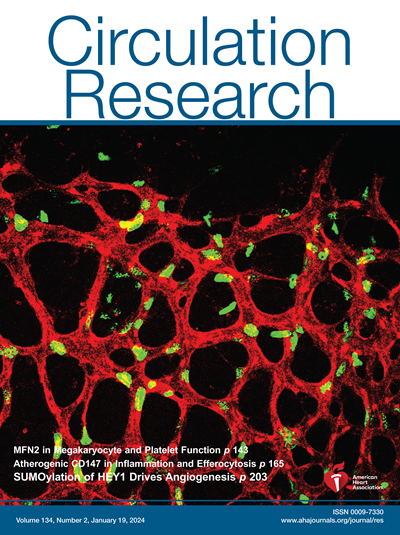Treg细胞通过NLRC3信号通路减弱PH-LHD患者肺静脉重构。
IF 16.5
1区 医学
Q1 CARDIAC & CARDIOVASCULAR SYSTEMS
引用次数: 0
摘要
背景:肺静脉重构是左心相关肺动脉高压(PH-LHD)的一个关键病理特征。本研究旨在探讨调节性T (Treg)细胞在这一过程中的作用。方法采用横断主动脉收缩小鼠模型和Foxp3-DTR/tdTomato小鼠细胞缺失模型,观察PH-LHD患者肺静脉周围Treg细胞的功能。为了证实Nlrc3-/- Treg细胞对PH-LHD的影响,我们使用了3种小鼠模型:Nlrc3敲除小鼠、胸腺发育小鼠和内皮细胞谱系追踪Cdh5CreERT2+/- mT/mG+/-小鼠。通过蛋白对接预测、共免疫沉淀和Treg细胞与静脉内皮细胞共培养,阐明Treg细胞在内皮向间质转化过程中的相互作用蛋白和信号通路。结果横主动脉缩窄诱导的PH-LHD患者肺静脉周围有大量streg细胞,streg细胞在促进炎症消退和抑制肺静脉重构中发挥重要作用。Nlrc3在PH-LHD小鼠和患者中的表达降低。NLRC3(核苷酸寡聚化结构域样受体家族CARD结构域包含3)缺乏抑制Treg细胞增殖,损害其免疫抑制和内皮到间质过渡保护作用。在机制上,NLRC3与TRAM (trf相关适配分子)相互作用,调节CD4+ T细胞中IRF3/NF-κB(核因子-κB) p65信号。nlrc3缺陷Treg细胞通过IRF3/NF-κB p65信号通路促进IL (interleukin)-18的表达,IL-18的分泌激活内皮细胞RTK(受体酪氨酸激酶)信号通路,促进肺静脉内皮细胞向间质转化进程和PH-LHD进展。该过程与IL-18结合蛋白在体内是可逆的。结论snlrc3在PH-LHD患者中对Treg细胞预防肺静脉重构起关键作用,主要通过调节IL-18的分泌,抑制内皮细胞向间质细胞的转化,从而改善疾病进展和预后。本文章由计算机程序翻译,如有差异,请以英文原文为准。
Treg Cells Attenuate Pulmonary Venous Remodeling in PH-LHD via NLRC3 Signaling.
BACKGROUND
Pulmonary venous remodeling is a key pathological feature of pulmonary hypertension associated with left heart disease (PH-LHD). This study aims to investigate the role of regulatory T (Treg) cells in this process.
METHODS
We used mouse models with transverse aortic constriction and cell depletion of Foxp3-DTR/tdTomato mice to examine Treg cells' function around pulmonary veins in PH-LHD in vivo. To confirm the effect of Nlrc3-/- Treg cells on PH-LHD, we utilized 3 mouse models: Nlrc3 knockout mice, athymic mice, and endothelial cell lineage tracing Cdh5CreERT2+/--mT/mG+/- mice. The interaction proteins and signaling pathways of Treg cells during endothelial-to-mesenchymal transition were elucidated by protein docking prediction, coimmunoprecipitation and cocultivation of Treg cells with venous endothelial cells.
RESULTS
Treg cells were abundant around pulmonary veins of transverse aortic constriction-induced PH-LHD and were essential for promoting inflammation resolution and inhibiting pulmonary venous remodeling. Nlrc3 expression was reduced in mice and patients with PH-LHD. NLRC3 (nucleotide-oligomerization domain-like receptor family CARD domain containing 3) deficiency inhibited Treg cell proliferation and impaired their immunosuppressive and endothelial-to-mesenchymal transition-protective effects. Mechanistically, NLRC3 interacted with TRAM (TRIF-related adaptor molecule) and regulated IRF3/NF-κB (nuclear factor-κB) p65 signaling in CD4+ T cells. NLRC3-deficient Treg cells promoted IL (interleukin)-18 expression through IRF3/NF-κB p65 signaling, and thus IL-18 secretion activated endothelial RTK (receptor tyrosine kinase) signaling, favoring endothelial-to-mesenchymal transition progression in pulmonary veins and PH-LHD progress. This process was reversible with IL-18 binding protein in vivo.
CONCLUSIONS
NLRC3 is crucial for Treg cells to prevent pulmonary venous remodeling in PH-LHD, primarily by modulating IL-18 secretion, which inhibits endothelial-to-mesenchymal transition and thereby improves disease progression and prognosis.
求助全文
通过发布文献求助,成功后即可免费获取论文全文。
去求助
来源期刊

Circulation research
医学-外周血管病
CiteScore
29.60
自引率
2.00%
发文量
535
审稿时长
3-6 weeks
期刊介绍:
Circulation Research is a peer-reviewed journal that serves as a forum for the highest quality research in basic cardiovascular biology. The journal publishes studies that utilize state-of-the-art approaches to investigate mechanisms of human disease, as well as translational and clinical research that provide fundamental insights into the basis of disease and the mechanism of therapies.
Circulation Research has a broad audience that includes clinical and academic cardiologists, basic cardiovascular scientists, physiologists, cellular and molecular biologists, and cardiovascular pharmacologists. The journal aims to advance the understanding of cardiovascular biology and disease by disseminating cutting-edge research to these diverse communities.
In terms of indexing, Circulation Research is included in several prominent scientific databases, including BIOSIS, CAB Abstracts, Chemical Abstracts, Current Contents, EMBASE, and MEDLINE. This ensures that the journal's articles are easily discoverable and accessible to researchers in the field.
Overall, Circulation Research is a reputable publication that attracts high-quality research and provides a platform for the dissemination of important findings in basic cardiovascular biology and its translational and clinical applications.
 求助内容:
求助内容: 应助结果提醒方式:
应助结果提醒方式:


